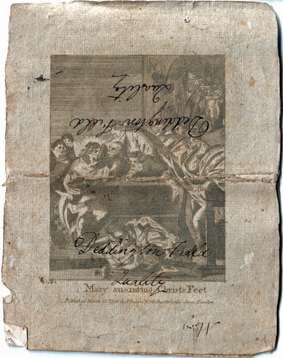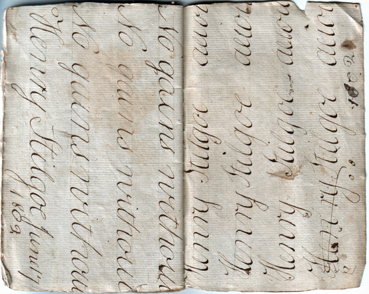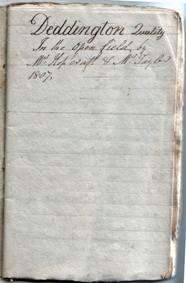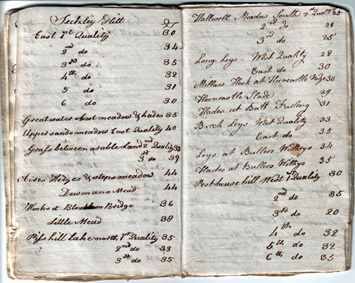Millennium Project
by Chris Day
‘Deddington Quality in the open field
by Mr Hopcraft & Mr Taylor 1807’
The existence of this notebook, a child's home-made exercise book, was made known only recently. It is a copy of the Deddington pre-enclosure Quality Book and was written by the young Henry Stilgoe (1795-1838). It has been passed down through the Stilgoe family, which farmed in and around Deddington since Tudor times. The original Quality Book has been lost, making this copy an important and fortunate survival. We are very grateful for permission to publish it here.
The DOL pages on the 1808 Enclosure Map and Key and Deddington Open Fields and Enclosure give useful background to this item.
|
|
The Deddington Field Quality notebook is approximately 8 by 5 inches and contains 64 pages (16 folded sheets) stitched together . It is clearly “home-made” by an early 19th century re-cycler. The outer cover consists of a print of “Mary anointing Christ’s Feet” folded in half. The reverse side of the print (that becomes the inner cover) has been used by Henry Stilgoe to practise writing his name. |
|
A second exercise sheet “No gains without pain” was folded and used for the next leaf. “Pain” has all but disappeared because the sheet has been trimmed down to the notebook size. Henry has kindly dated this exercise for us: 1802 (he would have been 6 or 7 years old) – at least 5 years before he copied the Quality Book. The picture opposite shows the inside back cover (Henry Stilgoe) on the right and the inner page (No gains..) on the left.
|
|
Prior to enclosure, Deddington’s large open fields (several hundred acres each, with a prairie-like appearance to modern eyes) were divided into furlongs which were further sub-divided into strips or lands. A farmer’s holdings comprised numbers of strips scattered more or less irregularly across the fields. The strips were held individually but farmed according to a communally agreed system of cultivation. Clifton and Hempton each had their own field systems, farmed in the same way; the fields of the neighbouring parish of Barford St Michael were intermingled with those of Hempton.
From the later 18th century pressure grew to enclose the whole parish, i.e. redistribute the strips in discrete blocks, thereby creating the distinct farms and fields with which we are familiar today. An Act of Parliament permitting this to happen was passed in 1807 and enclosure took place in 1808 (i.e. the whole parish, including Clifton and Hempton, plus Barford), a remarkably short period of time in which to survey the parish, to consult all those with an interest, and to redistribute some 4000 acres. The Deddington Award was one of perhaps 5000 Enclosure Acts in all, most of them passed between 1750 and 1850. Parliamentary enclosure was especially prevalent in the English Midlands, which were the heart of the open-field ‘system’.
An enclosure Act appointed commissioners (usually three, chosen to represent the various interests at stake) to supervise the surveying of the place and to oversee the process of reallocating the land. They were charged with giving due regard not only to the quantity of land but also to its quality. One advantage of the old scattered-strip system was that farmers were likely to have a mix both of better and poorer land. At enclosure it was important that the reallocation of land was perceived to be at least ostensibly fair. With that in mind quality surveyors (often called ‘qualiteers’ or ‘quality men’) were commonly employed: these were generally men with detailed local knowledge. Separate quality and quantity surveys were fairly usual until the 1790s, when professional commissioners skilled both in surveying and valuing land took over the whole process.
|
|
There were only two commissioners for the Deddington award: Robert Weston of Aynho, steward to the Cartwright family, and John Davis, a Bloxham farmer with considerable experience of enclosure. They seem to have favoured the slightly old-fashioned practice of employing separate quality surveyors, in this case ‘Mr Hopcraft and Mr Taylor’. No further identification is given, though they are most likely to have been local men. The Hopcrafts were a family of stonemasons and (latterly) builders in Deddington. The quality surveyor was almost certainly one of three brothers, John, James or William who all owned property in Deddington at that time. |
A Thomas Taylor was shown on the 1808 Award map as the owner of the cottage at the south-east corner of Tay's Gateway, at the junction with what is now Victoria Terrace. He is also referenced in the Stilgoe account of their landholdings c.1808 as (former?) owner of some "freehold allotments for odd lands" occupied by Henry Stilgoe.
The surveyors' working notes seem not to have survived. That is not surprising; such evidence is rare, presumably because once its purpose was served it was regarded as disposable. An enquiry at the Oxfordshire Record Office has elicited the response that quality books are otherwise known to have survived only for Sandford St Martin and Swalcliffe.
The Quality Book is deceptively simple. In 37 pages it documents approximately 300 pieces of land in the open fields - arable and meadow, furlongs, butts, leys, lands and yerds - providing, as it does so, many furlong names that were previously unknown. A personal favourite has to be ‘Shaligonaked’ furlong (p. 11).
These land-pieces are listed under 21 "localities", some of which are still known today e.g. Tomwell, Coombe Hill etc. It's possible that some of these were the names of the common fields around Deddington, Clifton, Hempton and Barford St. John.
Not all pieces have specific names; many are defined by their relationship to another or to a geographical feature. So, for example, in the Harbour's Hill locality there is "Mortar Mill Furlong", or "Furlong into Chapmans Leys", or "Lands shooting into Somerton Ford".
Land within a furlong is described as being of 1st quality, 2nd quality and so on down, in one remarkable instance, to thirteen different qualities (p. 17). The impression is of meticulousness. Each different quality of land has a number associated with it, between 20 and 50, but generally in the 30’s, and the heading "S" above this of this numeric column on each page. Theories abound as to what the “S” represents. Possibly “Shillings”, valuing the land, or “Selions” which is a measure of strips or ridges of land, or something else?
Following the assessment of the land there are six pages giving a list and brief description of 84 "Deddington Homesteads"’ generally with their proprietors. Some proprietors have more than one homestead and some homesteads have no proprietor. Again, each homestead has a number against it, again with a “S” as a column header.
|
|
Careful analysis might, or it might not, answer some of the many questions that the document raises. What do the numbers represent? Some sort of value perhaps, but of what? A strip? An acre? Occasionally lower quality land has a higher number than adjacent better: was that because it lay more conveniently for access, thereby inflating its value?
Or do the numbers represent some measure of area? Thus a furlong might have 32 units of 1st quality land, 30 of 2nd etc.
Why are so few homesteads listed? The parish’s population in 1801 was 1552, implying in excess of 300 houses, many more than in the Quality Book. And there is the problem that some properties in the Quality book do not have ascribed owners. An obvious explanation is that the homesteads listed in the Quality Book are only those entitled to an allocation of land at enclosure. But in that case, why are so many more people listed at enclosure in 1808?
And what do the homestead numbers represent? They range from 35 to 60; all apart from 2 (42 and 48) being divisible by 5. Most of them are either 50, 55 or 60..
The Quality Book therefore comes with a health warning. We hope to supply some of the answers in time*, but some aspects of the survey are likely to remain enigmatic. Nevertheless, we can count ourselves lucky to have this rare survival of an episode that arguably had a greater impact than any other in Deddington’s recorded history.
* Answers to these questions arrived on 25 February by a very welcome email which is self explanatory and is reproduced in full following:
From: Bill Franklin
Date: 25 February 2016 at 09:28
Subject: Deddington Quality Book
Dear Editor,
On recently searching for an item regarding enclosure acts I came upon your excellent website. On viewing
the part about the quality book I noted a number of questions you and your colleagues had about its content,
which having seen many hundreds of enclosure documents from 6 counties over the last decade, I am able to
answer. I have therefore set out below the questions in red, and the answers in black. I hope this is of some
use.
What do the numbers represent? The annual rental value per acre in shillings.
Occasionally lower quality land has a higher number than adjacent better: was that because it lay
more conveniently for access, thereby inflating its value? To understand this you have to
understand the process. The commissioners or specifically employed Quality Men or Qualiteers
entered a furlong with the details of the owners claims. If in a large furlong there were some
pieces of land valued at 60s. and some at 40s., they noted the value of the first they came to (on
entering the furlong) as the 1st quality, even though that might have been the one with the lower
value. They would then mark out all the strips in that quality, and then mark out the strips in the
other qualities, marking them as 2nd, 3rd etc. These were noted in the quality book by the
surveyor who followed the qualiteers around the fields. The surveyor would then survey in detail
every strip, close, meadow etc., and in a survey book kept by the commissioners (and put on
public display) he would set out for each, the owner, sometimes the strip name, the area in acres,
roods and perches, the quality value and the total value in £. s. d., this being the acreage
multiplied by the quality value. It has to be remembered that before enclosure most land had not
been accurately surveyed and the description found in claims etc., was [no of acres] “more or
less”.
Why are so few homesteads listed? The qualiteers were only interested in those pieces of land to
be enclosed, not all the houses in the village. Not everyone owned land, most people rented their
cottage with its garden and these would have been excluded from the valuation. A few will have
held rights of common over the open fields. These rights will have been associated with their
cottage, and would appear in the quality book, as the commissioners needed to give them land in
lieu of their loss of common rights. Such land was usually placed near to their cottage. Hence the
number of homesteads mention is always less than the number of dwellings. Most of the
homesteads listed in the quality book are farm yards, orchards and gardens associated with
particular farms, not necessarily next to them. These might be given to a cottager in lieu of
common rights, the land owner being compensated with land next to his main allotment.
And what do the homestead numbers represent? As above, the rental value in shillings per
annum.
Best wishes William Franklin
Thanks to Colin Cohen, who scanned the Quality Book spread by spread, we are able to make an image of the complete book available online. Additional thanks to Jon Malings who has transcribed it, attempting to retain the format of the original document.
Click here to see the image (a PDF, 1.6Mb.)
Click here to see the transcription (a PDF, 67Kb)
In addition, you can download our EXCEL spreadsheet if you want to manipulate the data yourself.
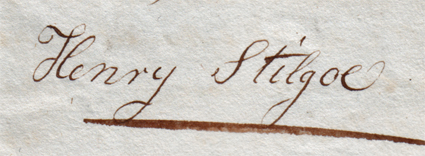 |
